 Last additions - GIFU 岐阜県 Last additions - GIFU 岐阜県 |

Jan 19, 2009
|
|

Even toward the city center, mostly trees blocking the worthless view.Jan 19, 2009
|
|

Portraits of all the lords of Ogaki Castle.Jan 19, 2009
|
|

Taiko drum on top floor.Jan 19, 2009
|
|

Even computers for more info.Jan 19, 2009
|
|

View from the top floor of Ogaki Castle tower. This faces the adjacent park.Jan 19, 2009
|
|

Toda Kazuaki (1541-1603), first lord of Ogaki Castle. 戸田一西Jan 19, 2009
|
|

Top 4th floor of Ogaki Castle tower. There is no balcony, only glass windows.Jan 19, 2009
|
|

Toda Ujitaka (1854-1936), last lord of Ogaki Castle. (Toda family)Jan 19, 2009
|
|

Jan 19, 2009
|
|

Writing by Ishida Mitsunari and other allies. (Facsimile)Jan 19, 2009
|
|

Model of a battleJan 19, 2009
|
|

Range of various weapons: Spear 6 meters, arrow 30 meters, bullet 200 meters, and cannon 1800 meters.Jan 19, 2009
|
|

Explaining the parts of samurai armor.Jan 19, 2009
|
|

Parts of a samurai warrior on horseback.Jan 19, 2009
|
|

The first floor has exhibits related to Ogaki Castle and the Battle of Sekigahara. Samurai armorJan 19, 2009
|
|

Touch-and-feel samurai weapons. Matchlock gun, bow, and spear (behind).Jan 19, 2009
|
|

Deadly spearsJan 19, 2009
|
|

Inside Ogaki Castle tower that is a castle history museum with a good display of samurai stuff.Jan 19, 2009
|
|

East Gate, now the main gate to Ogaki Castle. 東門Jan 19, 2009
|
|

Turn here to visit Ogaki Castle.Jan 19, 2009
|
|

From Ogaki Station, a straight shopping road (Eki-dori) goes through the center of the city. A marker shows where you turn to visit Ogaki Castle.Jan 19, 2009
|
|

Ogaki Castle's East Gate (looking from the inside). This is not the Omotemon front gate which was a distance away from here (photos at bottom).Jan 19, 2009
|
|
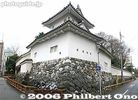
The original Ogaki Castle was said to be built in 1535 by the Toki Clan who ruled Mino Province (now Gifu).Jan 19, 2009
|
|

Ogaki Castle's East Gate (looking from the inside).Jan 19, 2009
|
|
|

Ieyasu and his gang.Jan 14, 2009
|
|

Tokugawa IeyasuJan 14, 2009
|
|

After the hour-long play ended, a photo opp for all. Mitsunari and his gang here.Jan 14, 2009
|
|

A woman samuraiJan 14, 2009
|
|
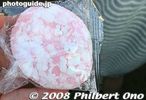
I caught one. Pure mochi (no adzuki bean paste inside). It was a very impressive and enjoyable festival.Jan 14, 2009
|
|

Ieyasu (left) and Mitsunari then walked toward each other and bowed to everyone together.Jan 14, 2009
|
|

Tokugawa Ieyasu kneeling.Jan 14, 2009
|
|

Tokugawa Ieyasu Jan 14, 2009
|
|

A final salute, Ishida's forces.Jan 14, 2009
|
|

The Sekigahara Ondo dance was then held. 関ヶ原音頭Jan 14, 2009
|
|

Photo oppJan 14, 2009
|
|

Fierce samuraiJan 14, 2009
|
|

Ishida Mitsunari kneeling.Jan 14, 2009
|
|

Jan 14, 2009
|
|

Ieyasu (left) and Mitsunari bowing to everyone.Jan 14, 2009
|
|

Water tower painted in Sekigahara motif.Jan 14, 2009
|
|

Mock battle staged during the Battle of Sekigahara Festival.Jan 14, 2009
|
|
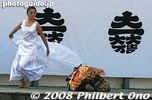
An angelic dancer then came to cover Ishida's body with a white cloth.Jan 14, 2009
|
|

Tokugawa Ieyasu retainer at the Battle of Sekigahara Festival, 2008Jan 14, 2009
|
|

Jan 14, 2009
|
|

Plastic samurai armorJan 14, 2009
|
|

Spear-wielding women warriors (with foxy makeup on).Jan 14, 2009
|
|

Tokugawa Ieyasu at the Battle of Sekigahara Festival, 2008Jan 14, 2009
|
|

Jan 14, 2009
|
|

The finale was the throwing of mochi.Jan 14, 2009
|
|

Later, Ishida came back to life as he stood up and walked. People giggled.Jan 14, 2009
|
|

Jan 14, 2009
|
|

Ishida Mitsunari is beheaded and dies.Jan 14, 2009
|
|

Ishida's western forces on the left, and Ieyasu's eastern forces on the right.Jan 14, 2009
|
|

Ishida Mitsunari loses the battle, and is executed.Jan 14, 2009
|
|

Execution of Jan 14, 2009
|
|

Jan 14, 2009
|
|

Jan 14, 2009
|
|

Another lord dies in battle.Jan 14, 2009
|
|

Jan 14, 2009
|
|

Battle continues.Jan 14, 2009
|
|

Jan 14, 2009
|
|
|

Jan 14, 2009
|
|

Jan 14, 2009
|
|

Apparently they had women warriors too. Or maybe they did not have enough male actors to fit into the samurai costumes.Jan 14, 2009
|
|

My lord!!Jan 14, 2009
|
|

Jan 14, 2009
|
|

Jan 14, 2009
|
|

Jan 14, 2009
|
|

Jan 14, 2009
|
|

Samurai lay dead.Jan 14, 2009
|
|

Then Ieyasu's guns fired.Jan 14, 2009
|
|

The entire play was scripted and the speaking parts were prerecorded. The actors/actresses only had to move and didn't speak. They were all prompted by script prompters (seen on lower left).Jan 14, 2009
|
|

Jan 14, 2009
|
|

Tokugawa Ieyasu never engaged in actual combat.Jan 14, 2009
|
|

A total of about 130 actors/actresses took part, and 80 of them were recruited from all over Japan. A few were professional actors. The scale was much smaller than the 800 people recruited for the 400th anniversary in 2000.Jan 14, 2009
|
|

Tokugawa Ieyasu at Mt. Momokubari, his base camp near the Sekigahara battlefield.Jan 14, 2009
|
|

The matchlock gun battalions then appeared.Jan 14, 2009
|
|

The battle ensues.Jan 14, 2009
|
|

Tokugawa Ieyasu gives commands during the Battle of Sekigahara.Jan 14, 2009
|
|

Ishida's guns fire first.Jan 14, 2009
|
|

Jan 14, 2009
|
|

Ishida Mitsunari acting during the Battle of Sekigahara FestivalJan 14, 2009
|
|

Ieyasu's eastern forces.Jan 14, 2009
|
|

Jan 14, 2009
|
|

Jan 14, 2009
|
|

While Ishida Mitsunari was on the stage on the other side of the field.Jan 14, 2009
|
|

Tokugawa IeyasuJan 14, 2009
|
|

Ishida's western forces ready for battle.Jan 14, 2009
|
|

Soon after the samurai procession arrived at Fureai Hiroba Square at 2 pm, a mock battle was staged in the form of a narrated outdoor play. It opened with a lady walking across the field. 関ヶ原合戦絵巻2008Jan 14, 2009
|
|

Tokugawa Ieyasu was on one side of the field (Mt. Momokubari). The play mainly took the viewpoint of Ishida Mitsunari. 「義の人・三成〜運命の関ヶ原決戦〜」Jan 14, 2009
|
|

The troops enter town on a perfectly sunny day for a festival.Jan 14, 2009
|
|

Tokugawa IeyasuJan 14, 2009
|
|

Ishida's forces were on one side (seen here).Jan 14, 2009
|
|

Jan 14, 2009
|
|

Tokugawa IeyasuJan 14, 2009
|
|

Jan 14, 2009
|
|

Jan 14, 2009
|
|

Tokugawa IeyasuJan 14, 2009
|
|

Head of the procession. Mt. Ibuki can be seen in the background.Jan 14, 2009
|
|

Tokugawa Ieyasu leaving Sasaoyama.Jan 14, 2009
|
|

Jan 14, 2009
|
|

The foot of Sasaoyama is full of samurai and spectators.Jan 14, 2009
|
|

It was actually kind of humorous.Jan 14, 2009
|
|

Jan 14, 2009
|
|

A few spectators were on the route.Jan 14, 2009
|
|

The procession leaving Sasaoyama.Jan 14, 2009
|
|

Ishida MitsunariJan 14, 2009
|
|

Jan 14, 2009
|
|

After a brief ceremony, the samurai procession started to leave Sasaoyama at 1:30 pm. They headed for Jinbano (Fureai Hiroba Square).Jan 14, 2009
|
|

The matchlock gun battalion arrives as well.Jan 14, 2009
|
|
|

Jan 14, 2009
|
|

Jan 14, 2009
|
|

Ishida MitsunariJan 14, 2009
|
|

Ishida Mitsunari spotted me and my camera and posed for me. He's a friendly guy. Jan 14, 2009
|
|

With Mt. Sasaoyama and the larger Mt. Ibuki (to which Ishida escaped after the battle) in the background, the Sekigahara samurai procession makes its way to Fureai Hiroba at the town center.Jan 14, 2009
|
|

Ishida Mitsunari 全軍武者行列Jan 14, 2009
|
|

At the Monument for the decisive battle, one lord's troops give out a battle cry.Jan 14, 2009
|
|

Jan 14, 2009
|
|

Tokugawa IeyasuJan 14, 2009
|
|

Most of the forces who took part in the Battle of Sekigahara are represented. Banners with the lord's crest indicate who's who.Jan 14, 2009
|
|

Jan 14, 2009
|
|

Ieyasu retainerJan 14, 2009
|
|

Ishida Mitsunari posing for me. He said, "You got an unusual-looking camera." (Because I was shooting both stills and video.)Jan 14, 2009
|
|

At around 12:30 pm, some of the samurai staged a mock battle at Sasaoyama.Jan 14, 2009
|
|

Tokugawa Ieyasu at Sasaoyama.Jan 14, 2009
|
|

Ishida MitsunariJan 14, 2009
|
|

Great photo opp.Jan 14, 2009
|
|

And Tokugawa Ieyasu.Jan 14, 2009
|
|

Mock combat with a spectator.Jan 14, 2009
|
|

Ishida MitsunariJan 14, 2009
|
|

Ishida MitsunariJan 14, 2009
|
|

Jan 14, 2009
|
|

The Sekigahara samurai warriors arrived Sasaoyama at noon.Jan 14, 2009
|
|

Ishida MitsunariJan 14, 2009
|
|

Ishida Mitsu-nyan, another cat, was the most popular.Jan 14, 2009
|
|

Straw pole pieces cut by a sword.Jan 14, 2009
|
|

Jan 14, 2009
|
|

All these samurai were gathering at Sasaoyama for a procession to the Fureai Hiroba Square where a mock battle would be staged. This is Lord Shimazu Yoshihiro.Jan 14, 2009
|
|

This man wore newer samurai armor made of plastic.Jan 14, 2009
|
|

Mini banners for all the clans who battled at Sekigahara.Jan 14, 2009
|
|

Ishida Mitsu-nyan and his calligraphy brushJan 14, 2009
|
|

The smoke from the guns.Jan 14, 2009
|
|

Jan 14, 2009
|
|

Shimasako-nyan, a cat based on one of Ishida Mitsunari's retainers. しまさこにゃんJan 14, 2009
|
|

Jan 14, 2009
|
|

Matchlock gun warrior posing for pictures.Jan 14, 2009
|
|

Bento box lunches named after Ieyasu and Hideyoshi. 1000 yen.Jan 14, 2009
|
|

After the demo, they posed for pictures.Jan 14, 2009
|
|

A few lifesize mascots walked around the foot of Sasaoyama. This is Chacha Hime, the oldest Azai sister who became Yodogimi.Jan 14, 2009
|
|

This man wore authentic samurai armor, over a century old, made of metal. A family heirloom.Jan 14, 2009
|
|

Jan 14, 2009
|
|

Sekigahara samurai warriors gather at Sasaoyama.Jan 14, 2009
|
|

Ishida Mitsu-nyan goodsJan 14, 2009
|
|

Jan 14, 2009
|
|

Jan 14, 2009
|
|

Jan 14, 2009
|
|

Sword demoJan 14, 2009
|
|

Food and souvenir stalls at the Sasaoyama parking lot.Jan 14, 2009
|
|

They fired the gun a few times.Jan 14, 2009
|
|

Jan 14, 2009
|
|

Matchlock gun warriorJan 14, 2009
|
|

Jan 14, 2009
|
|

There are a number of matchlock gun battalions in Japan, and they often demonstrate the guns at festivals like this.Jan 14, 2009
|
|

A sword demonstration. He's cutting up a straw pole. That's one sharp knife. These people have licenses to carry these guns and swords.Jan 14, 2009
|
|
|
|

Load, get ready, and...Jan 14, 2009
|
|

Top of Mt. Sasaoyama.Jan 14, 2009
|
|

BOOM!!!Jan 14, 2009
|
|

FIRE!! Those guns make a huge noise.Jan 14, 2009
|
|

They are all dressed in colorful samurai armor.Jan 14, 2009
|
|

A few matchlock gun battalions gathered on the Sasaoyama stage.Jan 14, 2009
|
|

Stone monument on the top of Sasaoyama marking Ishida Mitsunari's base camp.Jan 14, 2009
|
|

Lookout deck on Mt. SasaoyamaJan 14, 2009
|
|

Near the foot of Sasaoyama is this clearing used as a stage.Jan 14, 2009
|
|

At 11 am, the gun battalions arrived.Jan 14, 2009
|
|

They get ready to fire their matchlock guns. (No bullets)Jan 14, 2009
|
|

View of the Sekigahara battlefield from the top of Mt. Sasaoyama.Jan 14, 2009
|
|

Smoke signal on Mt. Sasaoyama.Jan 14, 2009
|
|

Smoke signal on Mt. Sasaoyama. Also notice the bell on the left.Jan 14, 2009
|
|

Climbing to the top of Mt. Sasaoyama.Jan 14, 2009
|
|

People also climbed up Mt. Sasaoyama.Jan 14, 2009
|
|

Foot of Mt. SasaoyamaJan 14, 2009
|
|

Monument for the decisive battleJan 14, 2009
|
|

Foot of Mt. Sasaoyama was the other festival venue. The parking lot had food and souvenir stalls.Jan 14, 2009
|
|

Banners with the crest of Ishida Mitsunari and Tokugawa Ieyasu flank the Monument for the decisive battle, near Mt. Sasaoyama, where the fighting was the fiercest. 決戦地Jan 14, 2009
|
|

Festival bannerJan 14, 2009
|
|

Mt. Sasaoyama had a smoke signal rising.Jan 14, 2009
|
|

The Sekigahara Town Hall parking lots were used for flea markets, food stalls, and souvenir stands. These photos were taken on the second day of the festival when a samurai procession and mock battle were staged. Jan 14, 2009
|
|

Food stallsJan 14, 2009
|
|

On Oct. 18-19, 2008, the town of Sekigahara held a special festival to commemorate the Battle of Sekigahara. The last time they did this was in 2000 for the 400th anniversary of the battle. The main venue was near the town hall.Jan 14, 2009
|
|

On Oct. 19 during 10 to 11 am in the Sekigahara Fureai Center Hall, a free lecture about Ishida Mitsunari was given by a Shizuoka Univ. professor. The hall was packed.Jan 14, 2009
|
|

There were two festival venues. One was at the Fureai Hiroba Square (Jinbano) and the other was at Mt. Sasaoyama. A free shuttle bus plied between the two venues, but it was short enough to walk.Jan 14, 2009
|
|

Mt. Sasaoyama, the small hill that was Lord Ishida Mitsunari's base camp. Behind it is Mt. Ibuki.Jan 14, 2009
|
|

1000-meter elevation mark and Mt. Ibuki haiku poem by Basho, on Ibukiyama Driveway.Jan 13, 2009
|
|

Jan 13, 2009
|
|

View from Ibukiyama DrivewayJan 13, 2009
|
|
|
|

The driveway is open only during non-winter months.Jan 13, 2009
|
|

There is also a small park called the Ukai Hiroba 鵜飼ひろば。Aug 23, 2008
|
|

Near Nagara River is the homes of the cormorant fishing masters.Aug 23, 2008
|
|

Pine wood stored at one cormorant fishing master's home.Aug 23, 2008
|
|
|

Sign at one home of a cormorant fishing master. The fishing masters also perform cormorant fishing for the Imperial family 8 times a year at designated areas on Nagara River. The fish is offered to the Imperial family, Ise Shrine, and Meiji Shrine. 御料Aug 23, 2008
|
|

For the climax, called sogarami (joint-formation fishing), all six ukai cormorant fishing boats line up and proceed downriver together while they chase the fish to the shallows. 総がらみAug 23, 2008
|
|

Homes of the cormorant fishing masters. It may be possible to see their birds if you ask politely and if they are not busy.Aug 23, 2008
|
|

The cormorants go out on these fishing trips on an empty stomach. They are starving, and therefore motivated to hunt for fish. The six ukai fishing boats pass by, so you get ample chance to take pictures and videos.Aug 23, 2008
|
|

From this park, you can also watch the nightly ukai fishing on the river.Aug 23, 2008
|
|

They also showed us a sample of the ayu sweetfish that were caught. These are larger than normal ayu. Those caught by the cormorants are expensive. The fish die quickly in the bird's beak, preserving freshness. You can see the beak marks on the fish.Aug 23, 2008
|
|

The cormorant fishing boats then parked near the viewing boats and showed us how they feed/reward the starving birds with fish and then put back the birds in the basket cages.Aug 23, 2008
|
|

Ukai cormorant fishing boats docked near the cormorant fishing masters' homes. At the right time, you can watch them carry the birds to the boats as they prepare for the ukai fishing.Aug 23, 2008
|
|

The usho (cormorant fishing master) and nakanori (assistant). The fishing master has about 20 cormorants at his home. Since they live together, he and the birds are able to work well together. 鵜匠、なか乗りAug 23, 2008
|
|

So we finished eating dinner, and at around 7:45 pm, the first ukai cormorant fishing boat passed by. The order in which the fishing masters pass by and fish is decided by drawing lots. The fish catch varies depending on what order you fish.Aug 23, 2008
|
|

Amazing how the strings don't get tangled. The fishing master can quickly cut the rope in case it gets caught on rock underwater so the bird does not drown. Also see my YouTube video here.Aug 23, 2008
|
|

Sogarami, all six ukai cormorant fishing boats line up and chase the fish downriver together while the fishing masters shout "Hou-Hou." I. Photographing this is difficult since your flash cannot reach the boats. 総がらみAug 23, 2008
|
|

A neighboring boat shoot some fireworks.Aug 23, 2008
|
|

The torch fire is called kagaribi 篝火, the pine wood used for the fire is called matsuwariki 松割木, and the metal basket holding the burning wood is called kagari 篝. The pole holding the torch is called kagaribo 篝棒.Aug 23, 2008
|
|

The 122 tools (including the cormorant fishing boat) used by the fishing master are Important Tangible Properties. If you want to take pictures, flash and a high ISO speed are essential. Video is great too.Aug 23, 2008
|
|

After spitting out its catch, the bird goes back into the water. The title of usho 鵜匠 (cormorant fishing master) was created by Oda Nobunaga. Only the Nagara River ukai fishing masters have this title. Other cormorant fishermen are u-zukai 鵜使い.Aug 23, 2008
|
|

The ukai viewing boats are parked like so as they watch the ukai fishing boats pass by.Aug 23, 2008
|
|

We had ordered bento box lunches from the hotel. This kind of cruise probably cost 5,000 yen per person. Smoking is not allowed on the boat.Aug 23, 2008
|
|

The ukai viewing boats were parked right next to shore, so we could easily get out and go on land. We could walk to the toilet boat parked nearby.Aug 23, 2008
|
|

The lanterns in the boat were covered with bugs. Apparently harmless, but it got the girls and women squeamish.Aug 23, 2008
|
|

The burning torch provides light and attracts the sweetfish. The cormorants dive into the water to catch the fish. The bird then is pulled to the boat to spit out the fish. The ukai cormorant fishing master holds the leash to 10 to 12 birds.Aug 23, 2008
|
|

Also before the ukai fishing began, this little boat came round to sell beer and fireworks. My relatives, being rich, bought some fireworks for the kids.Aug 23, 2008
|
|

Nagara River, looking upstream. We departed at about 6:30 pm. 長良川Aug 23, 2008
|
|

We approach the parking place along with the other boats already parked next to the river shore.Aug 23, 2008
|
|

The light of the fireworks immediately attracted a swarm of bugs which died from the fire and dropped into the river. Stupid bugs.Aug 23, 2008
|
|

Boats awaiting passengers. We call them yakata-bune. The roof is shaped like a house roof. 屋形船Aug 23, 2008
|
|

After they took our picture in front of the boat (and later charged 1,000 yen for a 5x7 in. print), we started to board the large boat.Aug 23, 2008
|
|

Mt. KinkazanAug 23, 2008
|
|

Bento box lunch. It was pretty good. We also had a variety of soft drinks. Before the ukai fishing began, we had time to eat dinner.Aug 23, 2008
|
|

If you're staying at a hotel or ryokan in Gifu city, it's possible to have your hotel arrange the viewing of the cormorant fishing. I went to see ukai cormorant fishing through a luxury hotel on the river. The dock was a short walk from the hotel.Aug 23, 2008
|
|

Nagara River 長良川Aug 23, 2008
|
|

This is our ukai viewing boat called Dosan Maru, named after the famous lord of Gifu. All the ukai viewing boats have a name related to the Gifu area, Nagara River or ukai fishing. Notice the bento boxes. 道三丸Aug 23, 2008
|
|

Our boat was semi-human powered. I think this guy should be wearing a happi coat and a Chinaman's hat for better atmosphere and aesthetics.Aug 23, 2008
|
|

Ukai viewing boats head upstream to where the boats are parked next to the river shore.Aug 23, 2008
|
|

Ukai viewing boats going upstream with Mt. Kinkazan in the background. The castle is also lit at night.Aug 23, 2008
|
|

The viewing boats are called yakata-bune. They come in different sizes. 屋形船Aug 23, 2008
|
|

Inside one boat. The floor has tatami mats. A low table is also provided. No dinner provided on this boat.Aug 23, 2008
|
|

Mt. Kinkazan, topped with Gifu Castle, is a prominent sight on Nagara River. 金華山Aug 23, 2008
|
|

The larger yakata-bune has a silent, battery-powered outboard motor. Notice the solar panels on the roof. 屋形船Aug 23, 2008
|
|

With passengers aboard, the boats depart one after another, heading upstream.Aug 23, 2008
|
|

The fishing master's handmade skirt (koshimino) is made of straw. It functions as a raincoat and provides warmth. He makes and wears out four or five skirts each year. Underneath is just shorts. 腰蓑(こしみの)Aug 23, 2008
|
|

The smaller yakata-bune, like this one, is human-powered.Aug 23, 2008
|
|

After the ukai talk, passengers start to board the ukai viewing boats at 6:15 pm. Course B passengers will board at 6:45 pm or 7:15 pm. Course B is for people who just want to see the cormorant fishing, and don't care to spend much time on the boat.Aug 23, 2008
|
|
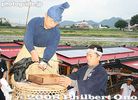
The bird then spits out the fish. The person on the right is the fishing master's son being groomed to take over his father's job. The fishing master has been doing this for 50 years. It is a hereditary position and occupation. 鮎Aug 23, 2008
|
|
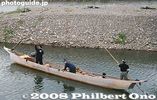
The ukai fishing master's ukai cormorant fishing boat is called ubune. Accompanied by an assistant (middle) called the nakanori and the steerer (at rear) called tomonori. About 13 meters long. 鵜舟(うぶね)= 鵜匠+供乗り(とものり)Aug 23, 2008
|
|

He took out one of the cormorants from the basket cage. In Japanese, the bird is called umi'u. They normally fish in the ocean as opposed to the kawa'u river cormorant which are smaller and have been devastating to the fish in Lake Biwa.Aug 23, 2008
|
|
| 2991 files on 12 page(s) |
 |
 |
 |
10 |  |
|